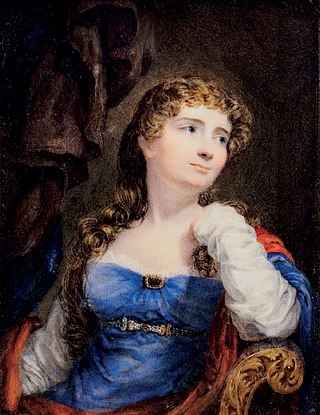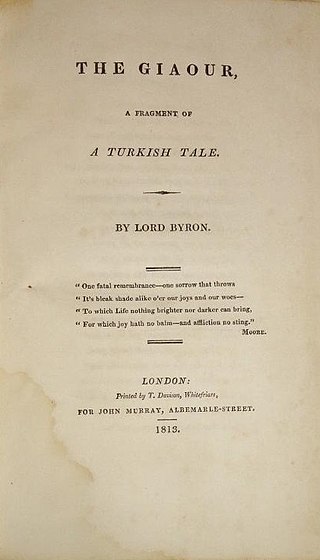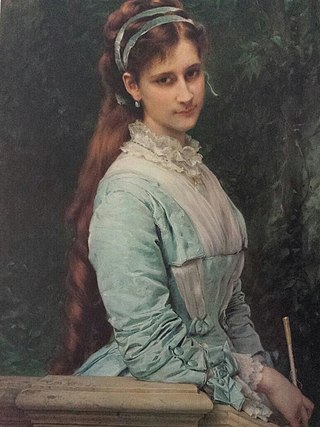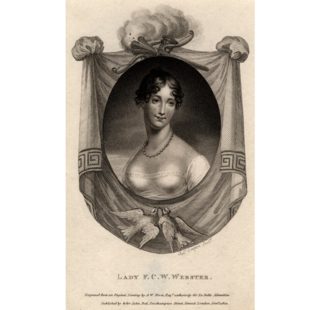
Augusta Maria Leigh was the only daughter of John "Mad Jack" Byron, the poet Lord Byron's father, by his first wife, Amelia, née Darcy.

The Byronic hero is a variant of the Romantic hero as a type of character, named after the English Romantic poet Lord Byron. Both Byron's own persona as well as characters from his writings are considered to provide defining features to the character type.

Anne Isabella Noel Byron, 11th Baroness Wentworth and Baroness Byron, nicknamed Annabella and commonly known as Lady Byron, was an educational reformer and philanthropist who established the first industrial school in England, and was an active abolitionist. She married the poet George Gordon Byron, more commonly known as Lord Byron, and separated from him after less than a year, keeping their daughter Ada Lovelace in her custody despite laws at the time giving fathers sole custody of children.
This is a chronology of events in the life of George Gordon Byron, 6th Baron Byron. Each year links to its corresponding "year in poetry" article:

The Corsair (1814) is a long tale in verse written by Lord Byron and published by John Murray in London. It was extremely popular, selling ten thousand copies on its first day of sale, and was influential throughout the following century, inspiring operas, music and ballet. The 180-page work was dedicated to Irish poet Thomas Moore.

Manfred: A dramatic poem is a closet drama written in 1816–1817 by Lord Byron. It contains supernatural elements, in keeping with the popularity of the ghost story in England at the time. It is a typical example of a Gothic fiction.

The Giaour is a poem by Lord Byron first published in 1813 by John Murray and printed by Thomas Davison. It was the first in the series of Byron's Oriental romances. The Giaour proved to be a great success when published, consolidating Byron's reputation critically and commercially.

Marquis de Morès et de Montemaggiore was a French duelist, frontier ranchman in the Badlands of Dakota Territory during the final years of the American Old West era, a railroad pioneer in Vietnam, and antisemitic politician in his native France.

Elizabeth Medora Leigh was the third daughter of Augusta Leigh. It is widely speculated that she was fathered by her mother's half-brother Lord Byron; this is supported by comments from his widow, even though her mother's husband, Colonel George Leigh, was her legal father.

Medora de Vallombrosa, Marquise de Morès, was an American heiress who married the Marquis de Morès.
Nationality words link to articles with information on the nation's poetry or literature.

The Chateau de Mores in Medora, North Dakota, United States, is a historic home built by the Marquis de Mores in 1883 as a hunting lodge and summer home for his family and guests. The home is now part of the 128-acre (0.52 km2) Chateau de Mores State Historic Site, which also includes Chimney Park and de Mores Memorial Park.

Captain John Byron was a British Army officer and letter writer, best known as the father of the poet Lord Byron. In 1824, an obituary of his son gave him the nickname "Mad Jack Byron", and though there is no evidence for this in his own lifetime, it has since stuck – certainly he was called "Jack" by his family members and referred to himself as such.

George Gordon Byron, 6th Baron Byron was an English poet and peer. He is one of the major figures of the Romantic movement, and is regarded as being among the greatest of English poets. Among his best-known works are the lengthy narratives Don Juan and Childe Harold's Pilgrimage; much of his shorter lyrics in Hebrew Melodies also became popular.

George Gordon Byron, 6th Baron Byron of Rochdale, better known as the poet Lord Byron, was born 22 January 1788 in Holles Street, London, England, and from 2 years old raised by his mother in Aberdeen, Scotland before moving back to England aged 10. His life was complicated by his father, who died deep in debt when he was a child. He was able to work his way through school, and his life advanced after he inherited both his great-uncle's title in 1798 and the Newstead Abbey estate.
John Trevanion Purnell Bettesworth-Trevanion was a Cornish politician. He rebuilt Caerhays as a Gothic-style castle.
Robert Charles Dallas was a Jamaican-born British poet and conservative writer. He is known also for a contentious book on Lord Byron, and a history of the Second Maroon War.

Lady Frances Caroline Wedderburn-Webster was an Anglo-Irish woman who became a figure of scandal of the Regency period, for her supposed affairs with the leading celebrities, Lord Byron and the Duke of Wellington. It may be that neither of those relationships went beyond flirtation.
Duke of Vallombrosa was a title created for the House of Manca. The present holder is disputed.














